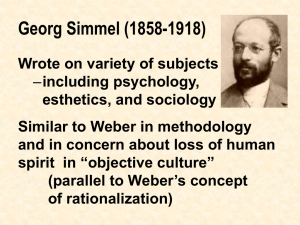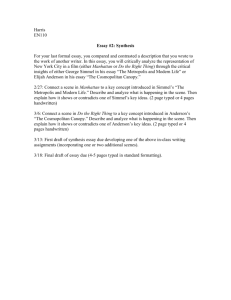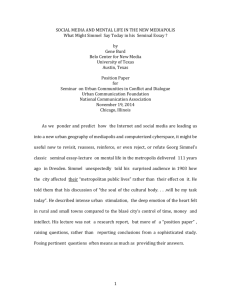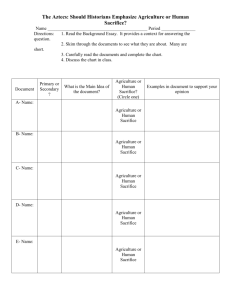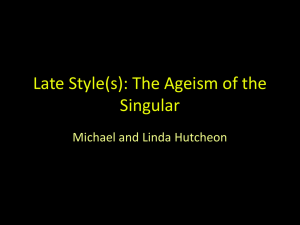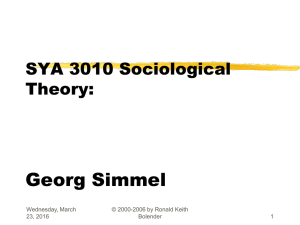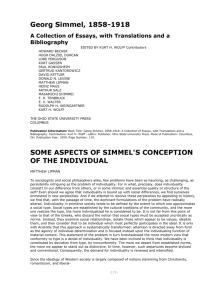Chapter 6
advertisement
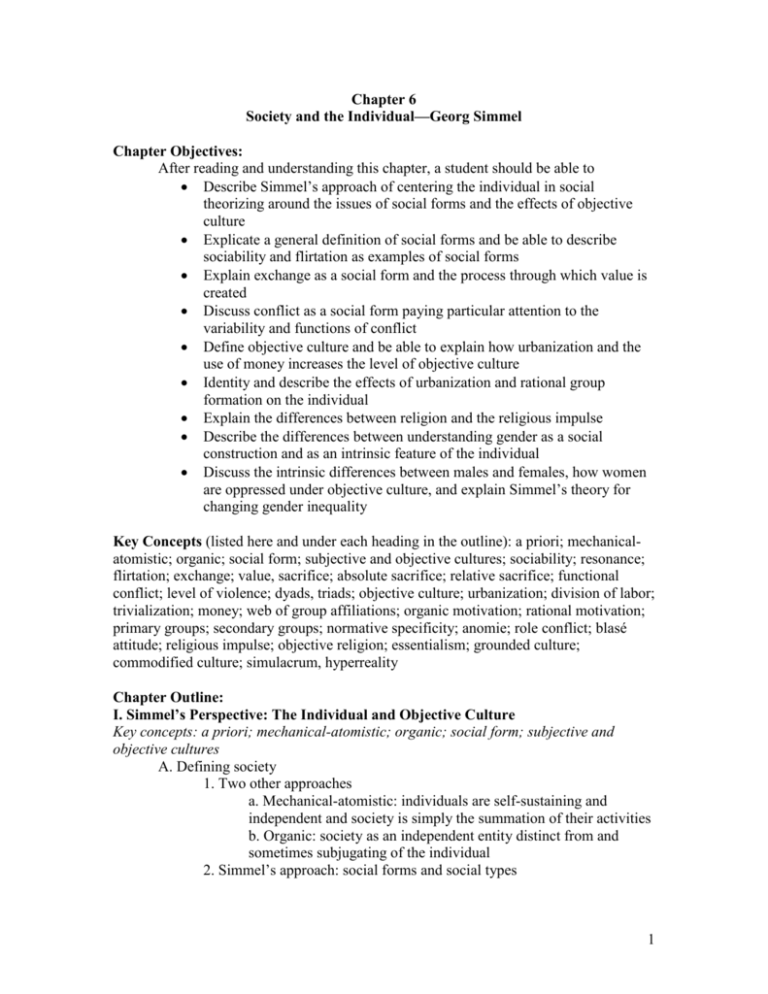
Chapter 6 Society and the Individual—Georg Simmel Chapter Objectives: After reading and understanding this chapter, a student should be able to Describe Simmel’s approach of centering the individual in social theorizing around the issues of social forms and the effects of objective culture Explicate a general definition of social forms and be able to describe sociability and flirtation as examples of social forms Explain exchange as a social form and the process through which value is created Discuss conflict as a social form paying particular attention to the variability and functions of conflict Define objective culture and be able to explain how urbanization and the use of money increases the level of objective culture Identity and describe the effects of urbanization and rational group formation on the individual Explain the differences between religion and the religious impulse Describe the differences between understanding gender as a social construction and as an intrinsic feature of the individual Discuss the intrinsic differences between males and females, how women are oppressed under objective culture, and explain Simmel’s theory for changing gender inequality Key Concepts (listed here and under each heading in the outline): a priori; mechanicalatomistic; organic; social form; subjective and objective cultures; sociability; resonance; flirtation; exchange; value, sacrifice; absolute sacrifice; relative sacrifice; functional conflict; level of violence; dyads, triads; objective culture; urbanization; division of labor; trivialization; money; web of group affiliations; organic motivation; rational motivation; primary groups; secondary groups; normative specificity; anomie; role conflict; blasé attitude; religious impulse; objective religion; essentialism; grounded culture; commodified culture; simulacrum, hyperreality Chapter Outline: I. Simmel’s Perspective: The Individual and Objective Culture Key concepts: a priori; mechanical-atomistic; organic; social form; subjective and objective cultures A. Defining society 1. Two other approaches a. Mechanical-atomistic: individuals are self-sustaining and independent and society is simply the summation of their activities b. Organic: society as an independent entity distinct from and sometimes subjugating of the individual 2. Simmel’s approach: social forms and social types 1 a. Definition: a patterned mode of interaction through which people obtain their individual goals i. Preserves sense of individual ii. Provides basis of collective interaction and intersubjective experience without positing society as a supra-individual entity b. Social types: forms imply social types—types of people that occupy positions within a social form (examples: stranger, adventurer, competitor, and miser) B. Subjective and objective cultures 1. Definitions a. Subjective culture: a body of culture that is small enough for one individual to grasp, experience, use, and emotionally embrace b. Objective culture: culture that an individual cannot grasp in its entirety, cannot entirely use, and in which she or he has little or no emotional investment. 2. Central issue: social forms and types that take on objective existence and in turn have objectifying influences on the individual Simmel’s unique focus of study is the individual as the tension point between subjective and objective cultures. II. Social Forms Key concepts: sociability; resonance; flirtation; exchange; value, sacrifice; absolute sacrifice; relative sacrifice; functional conflict; level of violence; dyads, triads A. Sociability and flirtation 1. Characteristics of sociability a. Interaction as end in itself b. Objective features left outside the interaction c. Only certain subjective features allowed 2. Functions of sociability a. Pure social connection b. Resonance c. Playful affirmation of social realities d. Solves the problem of association: measure of meaning and importance that belongs to the individual as compared to society e. Affirmation of sense of self 3. Example: flirtation a. Hints at consent and denial without letting the interaction come to either b. Both parties must play c. Function of clothing B. Social form of exchange 1. General characteristics of exchange a. Typical of all interactions: exchange defined in terms of reciprocity b. Places all events and people within a value nexus 2 2. Value determinates a. Scarcity b. Sacrifice—two types i. Absolute ii. Relative C. Social form of conflict 1. General characteristics of conflict a. Conflict instinctual for humans b. Unique feature of conflict for humans: goal oriented i. Opens up opportunities for negotiation and different types and levels of conflict 2. Variability of violence a. Clearly express and rational goals less violent b. Higher emotional involvement increase violence c. Transcendent goals increase violence 3. Functions of conflict a. For society at large—low-level (less violent) more frequent conflict i. Releases hostilities ii. Creates norms for dealing with conflict iii. Develops lines of authority and judiciary systems b. For individual groups—more violent i. Boundaries surrounding the group become stronger ii. Increased social solidarity iii. centralization of power iv. coalition formation D. Group size and configuration 1. Shift from dyad to triad a. Group as objective entity b. Possibility of social power c. Possibilities of mediators and indirect relations III. Objectifying Culture Key concepts: objective culture; urbanization; division of labor; trivialization; money; web of group affiliations; organic motivation; rational motivation; primary groups; secondary groups; normative specificity; anomie; role conflict; blasé attitude A. Objective and subjective cultures (Figure 6.1) 1. Variables creating objectified culture a. Absolute size b. Diversity of components c. Complexity 2. Forces that increase level of objective culture: urbanization, money, social networks B. Urbanization 1. Result of industrialization 2. Urbanization effects 3 a. Increased division of labor b. Increased market exchange and use of money c. Overstimulation C. Money: universal value system without intrinsic worth 1. Effects of money on individual a. Increase individual freedom b. Decreased emotional ties to material goods c. Decreased emotional ties to people (culture of calculation) d. Decreases moral constraints and increases anomie 2. Effects of money on society a. Creates exchange relations over longer distances and time b. Increases continuity among groups c. Increases level of trust d. Centralization of authority D. Social networks 1. Web of group affiliations: the number, frequency, and intensiveness of relationships among people 2. Two types of motivations for and patterns of group membership a. Organic motivation i. Primary groups b. Rational motivation ii. Rational motivation 3. Effects of rational group membership a. Unique personalities b. Decreased normative specificity c. Increased anomie d. Increased role conflict e. Blasé attitude together, tend to create a social psychological need to exaggerate statements of difference IV. Two Objective Institutions: Religion & Gender Key concepts: religious impulse; objective religion; essentialism A. Religion 1. By nature humans are religious a. Religious impulse: psychological need for i. Experiencing completeness in what is otherwise a fragmentary world ii. Having a fixed point in a world that is ever-changing iii. An overarching just purpose for life iv. A force that can reconcile conflicts between people v. An external object toward which our human nature can be directed b. Certain feelings are distinctly religious: love, faith, giving 2. Objective religion 4 a. Creates objective categories that creates a new world beside the one that is truly religious B. Gender 1. Simmel posits intrinsic gender differences a. Male characteristics i. Externalization and objectification ii. Historical norm: significance and achievement iii. Indigenous tragedy: frustration of creative impulse b. Female characteristics i. Holism and fidelity ii. Historical norm: beauty—a particular grace; a perfection that calls forth delight for itself rather than its uses; state of being where the inner and outer lives are in harmony one with another iii. Indigenous tragedy: external and historical conditions of life (male dominance and masculinized, objective culture) 2. Changing the social conditions of gender a. Problem: oppression of women and the social world generally defined in terms of masculine, objective culture b. One possible solution: increasing women’s participation in economy and politics i. Problems: 1) gauged in terms of individual participation rather than and real group-based change; 2) demands women to conform to and internalize masculine culture c. Simmel’s solution: create and honor distinctly female contributions and culture i. Advantages: Balances culture, meaning, and society at large V. Thinking About Modernity and Postmodernity Key concepts: grounded culture; commodified culture; simulacrum, hyperreality A. Objective trivializing culture in modernity 1. Differences between grounded culture and commodified culture a. Grounded culture emerges out of face-to-face interaction, is intended to create meaning, moral boundaries, norms, values, beliefs, and so on which in turn produces people as moral actors b. Commodified culture is produced according to capitalist and mass media considerations and is intended to seduce the viewer to buy products; rather than moral actors people are consumers. 2. Increasing objective, trivializing culture a. Simmel’s processes: urbanization, the division of labor, the use of money, and rationally motivated group memberships b. Additional postmodern processes: mass media and advertising B. Postmodern effects 1. Simulacrum: an image of an image of an image, which never referred to anything real in the first place (Disney’s Pirates of the Caribbean) 5 2. hyperreality: preference for simulated experiences rather than real ones—emotional experiences in images of reality that have been exaggerated to the grotesque and fantastic (breast implants and video games are good examples) Chapter Summary: There are two central ideas that form Simmel’s perspective: social forms and the relationship between the subjective experience of the individual and objective culture. Simmel always begins and ends with the individual. He assumes that the individual is born with certain ways of thinking and feeling and most social interactions are motivated by individual needs and desires. Encounters with others are molded to social forms in order to facilitate reciprocal exchanges. These forms constitute society for Simmel. Objective culture is that culture that is universal yet not alive to the individual’s subjective experience. Thus the person is unable to fully grasp, comprehend, or intimately know objective culture. The tension between the individual on the one hand and social forms and objective culture on the other is Simmel’s focus of study. There are a variety of social forms; among them are sociability, exchange, conflict, and group size. Sociability occurs in interactions that have no other goal than chitchat. Though the goal appears of no consequence, the functions of such interactions are important for the well-being of society and the person—they socially connect us to others, provide cultural and emotional capital, affirm social reality, and solve the problem of association. Reciprocal exchange is the foundation of society. Exchange is ordered by value and value is ordered by sacrifice and scarcity. Conflict is a social form that provides such functions as group solidarity, normative regulation, centralization of power, and coalition formation. The kind of function that conflict provides depends on whether the collective is a social system or group. Group size also functions as a social form. Triads, for example, involve power relations, whereas dyads do not. On the other hand, dyads are much more uncertain and thus perceived as unique due to their size. Urbanization increases the division of labor, the use of money, and changes the configuration of social networks. All of these have direct and indirect effects on the level of objective culture and its effects on the individual. The use of money increases personal freedom for the individual yet at the same time it intensifies the possibility of anomie, diminishes the individual’s attachment to objects, and increases goal displacement. People join groups for either rational or organic motivations. Rational motivations are prevalent in urban settings and imply greater personal freedom coupled with less emotional investment, and possible anomie and role conflict; organic motivations imply less personal freedom and greater social conformity coupled with increased personal and social certainty. Both gender and religion are natural states for human beings. Each person has a religious impulse and a certain degree of religiosity. Religion, on the other hand, acts like a categorical scheme, and it overextends the valid limits of religiosity. Religion thus objectifies the world by claiming exclusive right to such impulses as faith, love, and sacrifice, and by conceptualizing all available worlds through its scheme. Gender is also an essential attribute of humans. Men naturally objectify themselves as they 6 are motivated to produce. Women, on the other hand, are naturally integrated with all aspects of their being. Men operate through a dualistic knowledge system, seeking proofs for knowledge in the empirical world, while women’s way of knowing is nondualistic and centered. The problem of gender inequality is that men have dominated the social world and its culture. Culture, then, for the most part is objective and at odds with women’s nature. True gendered social change will come as women’s knowledge and way of being are valued as equally as men’s. Simmel was concerned about the effect of objective culture on the individual’s subjective existence. Postmodernists have taken that concern to another level. In times past, most of the culture was produced by people situated in real social groups that interacted over real issues. This grounded culture created real meanings and morally infused norms, values, and beliefs. In postmodernity, much of the culture is produced or colonized by capitalists using advertising and mass media. This historic shift implies that culture has changed from a representation of social reality to representations of commodified images, culture is produced rather than created, and people have changed from culture creators to culture consumers. In Baudrillard’s words, culture in postmodern society is filled with simulacrum that references hyperreality. 7
